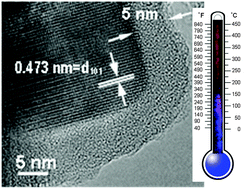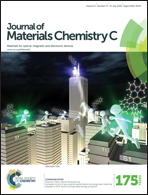Thermochromic upconversion nanoparticles for visual temperature sensors with high thermal, spatial and temporal resolution†
Abstract
Luminescence thermometry is one of the most currently studied approaches among the non-contact and non-invasive thermometry techniques working at the micro- and nanoscales, useful in situations where conventional thermometry is not able to make measurements, such as in the temperature mapping of microcircuits and microfluidics. Here we present the first, to the best of our knowledge, thermochromic temperature small scale sensor based on the blue to deep red color change of the upconverted light from Yb3+-sensitized Tm3+-doped GdVO4@SiO2 core–shell nanoparticles under near infrared (NIR) excitation (λexc = 980 nm). The electronic coupling of the corresponding 1G4 (blue) and 3F2 (deep red) Tm3+ emitting levels has been experimentally evidenced. Furthermore, we propose energy transfer schemes accounting for the thermal evolution of the electronic populations of these energy levels that support the temperature dependent ratiometric relationship between the intensities of the visible signals and thus provide the internal calibration to the temperature sensing system. To show the potentiality of our nanothermometer, we monitored the heating process produced by the Joule effect in a Pt wire, 50 μm in diameter, with thermal and temporal resolutions of ±0.1 K and <16 ms, respectively. The results matched very well with the theoretical modeling for this system.


 Please wait while we load your content...
Please wait while we load your content...